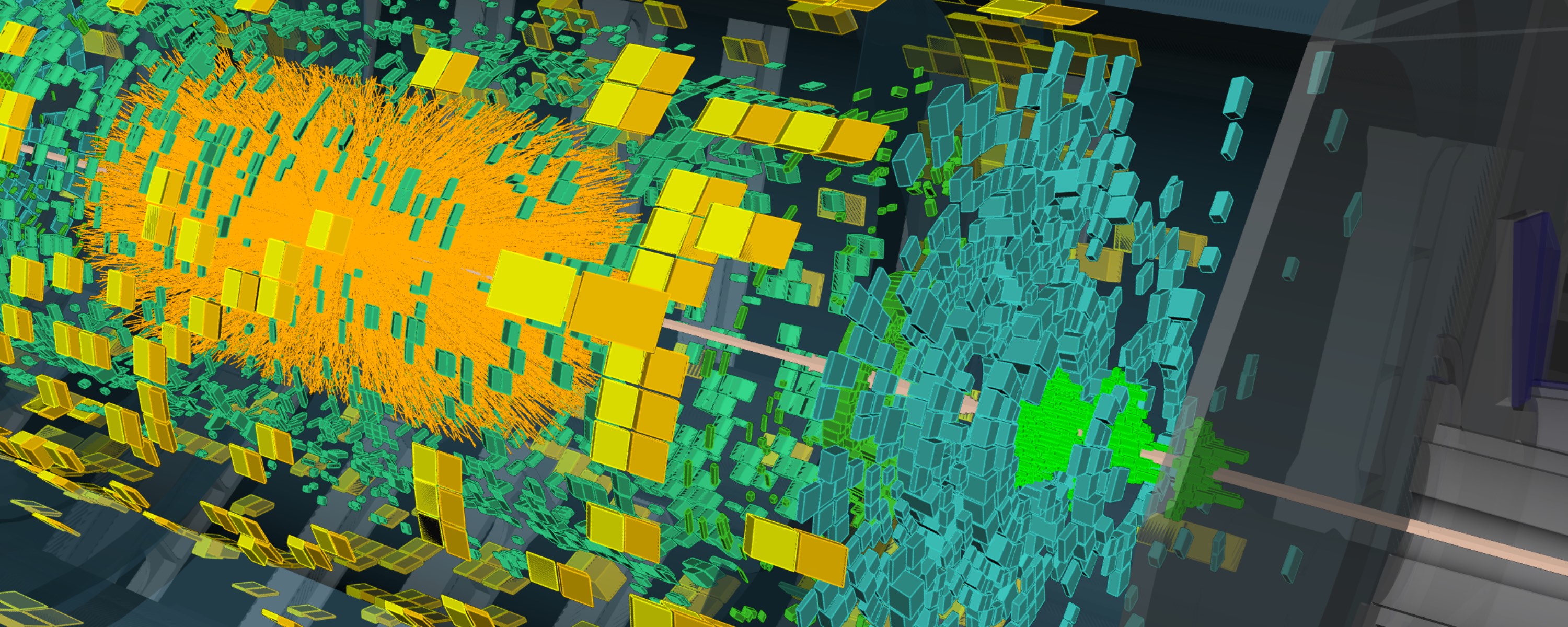ATLAS gives new insight into dijet suppression in heavy-ion collisions
22 April 2022 | By
Heavy-ion collisions at the LHC provide a unique opportunity for scientists to study the very hot and dense state of nuclear matter known as the quark-gluon plasma (QGP). These extreme conditions mimic those of the early Universe during the first micro-seconds after the Big Bang. Physicists are studying the properties of the QGP in order to gain access to the strong force and understand its unique properties.
At the recent Quark Matter 2022 conference in Krakow (Poland) members of the ATLAS Collaboration presented a new study of “jets” of particles travelling through the QGP. The result provides new insight into dijet suppression due to interactions with the nuclear medium.
To understand how this was achieved, one first should understand the types of heavy-ion collisions that take place in ATLAS. The LHC accelerates beams made up of heavy ions – the nuclei of lead atoms – which are large relative to their constituent protons and neutrons. The overlap between two colliding nuclei and, by extension, the QGP size formed in the collision, is characterised experimentally by the event centrality. A centrality of 0-10% corresponds to maximal overlap, and larger numbers correspond to more “peripheral” or “glancing” collisions. As the jets are modified as they travel through an extended region of plasma, the QGP’s effects can vary widely depending on the event centrality.
The ATLAS Collaboration has released a new study of “jets” of particles travelling through the QGP. The result provides new insight into dijet suppression due to interactions with the nuclear medium.
Physicists are able to study this medium by measuring the particles associated with quarks and gluons produced during the initial heavy-ion collision. As these particles must travel through the QGP before they are measured in the ATLAS detector, they can interact via the strong force with the quarks and gluons within the medium. This results in modifications to their trajectory and the emission of additional particles. As particles leave the QGP, they undergo hadronisation and create jets. Researchers had previously seen that particle–QGP interactions result in the reduction of transverse momentum and suppression of jets in heavy-ion collisions relative to proton-proton collisions.
In heavy-ion collisions, jets are typically formed from elastic scattering of quarks and gluons within the protons and neutrons contained in the two nuclei. Since they are colliding head-on, the scattering process leads to two outgoing quarks or gluons which have the same transverse momenta (pT) but in opposite directions. These quarks and gluons then evolve into two jets (referred to as dijets), which travel different trajectories through the QGP. By studying the transverse-momentum balance (xJ) of these dijets, physicists can gain insight into the path-length dependence to jet energy loss. The shapes of these distributions were previously studied using Run-1 data, where significant modification from proton-proton collisions was observed in lead-ion collisions.

For their latest study, ATLAS physicists examined lead-ion collision data collected in 2015 and 2018, as well as proton-proton collision data collected in 2017 (both recorded with a centre-of-mass energy of 5.02 TeV). They performed detailed studies of the yield of dijets as a function of xJ. By studying the yields, as opposed to just the shape of the distributions, physicists were able to gain new and surprising information on the suppression of dijets. Their measurements, as seen in Figure 1, demonstrate that the significant broadening observed in lead-ion collisions stems from a favourable suppression of symmetric jet pairs (xJ closer to 1), while highly unbalanced dijets see little to no modification relative to proton-proton collisions. This provides a new constraint for theoretical models seeking to understand the path-length dependence to jet energy loss.

As dijets are produced favouring balanced transverse momentum prior to interactions with the QGP, the subleading jet measured in heavy-ion collisions is more likely to have lost more energy relative to the leading jet. Therefore, by studying subleading jets, physicists can have enhanced sensitivity to jet-energy loss effects. In order to quantify this, for the first time, ATLAS researchers measured the suppression of leading and subleading jets within the dijet. They observed significant suppression of subleading jets relative to leading jets for all lead-ion-collision centrality, with the most peripheral collisions having a three sigma significant relative suppression as shown in Figure 2.
In summary, these new measurements of dijet production in heavy-ion collisions provide insight into the details of dijet suppression – with clear indications that jet suppression occurs primarily when the jets have similar transverse momenta, while more unbalanced jets are produced at similar rates to proton-proton collisions. These observables have clearly demonstrated significant sensitivity to even small amounts of jet energy loss and will be able to provide unprecedented access to jet quenching in the planned collisions of oxygen ions in Run 3.
Learn more
- Measurements of the suppression and correlations of dijets in Pb+Pb collisions at 5.02 TeV (HION-2019-02)
- Quark Matter 2022 presentation by Timothy Thomas Rinn: Novel measurements of dijet quenching with ATLAS
- Measurement of the nuclear modification factor for inclusive jets in Pb+Pb collisions at 5.02 TeV with the ATLAS detector (Phys. Lett. B 790 (2019) 108, arXiv: 1805.05635, see figures)
- Measurement of jet pT correlations in Pb+Pb and pp collisions at 2.76 TeV with the ATLAS detector (Physics Letters B 774 (2017) 379, arXiv: 1706.09363, see figures)
- See also the full lists of ATLAS Conference Notes and ATLAS Physics Papers.




